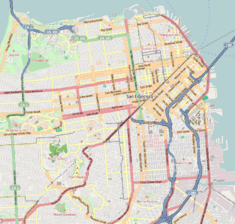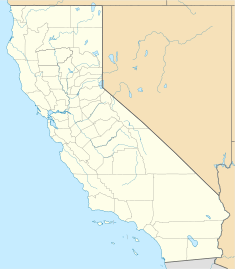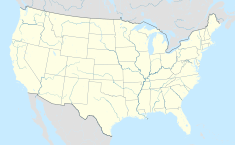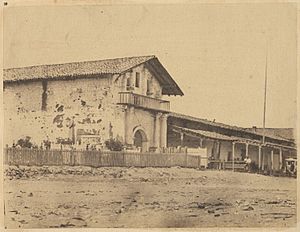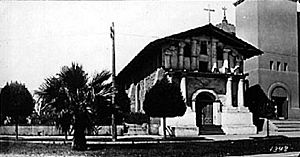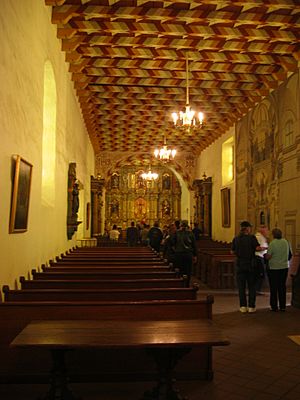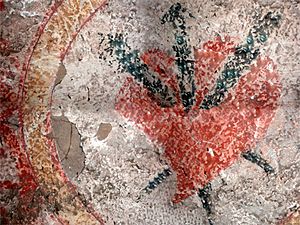Mission San Francisco de Asís facts for kids
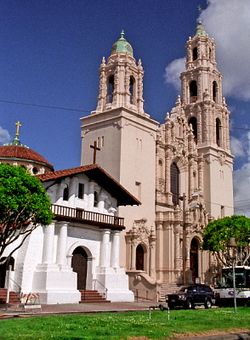
Mission Dolores adobe chapel (left) and Mission Dolores Basilica
|
|
| Location | 320 Dolores Street San Francisco, California 94114 |
|---|---|
| Coordinates | 37°45′51.8″N 122°25′37.3″W / 37.764389°N 122.427028°W |
| Name as founded | La Misión de Nuestro Padre San Francisco de Asís |
| English translation | The Mission of Our Father Saint Francis of Assisi |
| Patron | Saint Francis of Assisi |
| Nickname(s) | "Mission Dolores" |
| Founding priest(s) | Francisco Palóu; Junípero Serra |
| Founding Order | Sixth |
| Military district | Fourth |
| Native tribe(s) Spanish name(s) |
Ohlone Costeño |
| Native place name(s) | Chutchui |
| Baptisms | 6,898 |
| Marriages | 2,043 |
| Burials | 11,000= 5,000 (Europeans/Americans), 6,000 (Indians) |
| Secularized | 1834 |
| Returned to the Church | 1857 |
| Governing body | Roman Catholic Archdiocese of San Francisco |
| Current use | Parish Church |
| Designated | 1972 |
| Reference no. | #72000251 |
| Official name: Site of original Mission Dolores chapel and Dolores Lagoon | |
| Reference no. | 327-1 |
| Designated | April 11, 1968 |
| Reference no. | 1 |
| Website | |
| http://www.missiondolores.org | |
The Mission San Francisco de Asís, also known as Mission Dolores, is a very old Catholic church in San Francisco, California. It was started in the 1700s by Spanish Catholic missionaries. Today, the Archdiocese of San Francisco runs it.
The mission has two important buildings:
- The Mission Dolores adobe chapel was finished in 1791. It is the oldest building still standing in San Francisco.
- The Mission Dolores Basilica was built much later, in 1918. In 1952, Pope Pius XII gave it a special title, making it a minor basilica.
The mission was founded on October 9, 1776. Two priests, Frs Francisco Palóu and Pedro Benito Cambón, started it. They were part of the Franciscan Order. Their goal was to bring Spanish settlers to Alta California and teach the local Ohlone people about their faith. The Ohlone people did most of the hard work to build the adobe chapel.
The Mission Dolores Basilica, built in the early 1900s, replaced an older brick church. That brick church was built in 1876 but was destroyed in the big San Francisco earthquake of 1906.
Contents
History of Mission Dolores
Early Years: 1700s
In March 1776, a Spanish missionary named Pedro Font explored the Bay Area. He helped choose the spot for the new mission. The missionaries named it San Francisco de Asís, after Francis of Assisi, who started the Franciscan Order.
People often called it Mission Dolores. This name came from a nearby creek, Arroyo de Nuestra Señora de los Dolores, which means "Our Lady of Sorrows Creek."
On October 9, 1776, the missionaries opened a small chapel. This was the start of Mission San Francisco. Some records say this first chapel was near where Camp and Albion Streets are today. Local Ramaytush Ohlone people began to join the mission around 1785. They later helped build the main mission church.
Building the adobe walls for the Mission Dolores church began in 1788. Ohlone workers made 36,000 bricks for it. By 1790, the walls were finished and painted white. Even while it was still being built, the missionary Junípero Serra held a mass there.
The Mission Dolores adobe church was completed in 1791. Its adobe walls were four feet thick! The roof beams were made of redwood. The ceiling had beautiful designs painted by Ohlone artists using natural plant dyes. The mission also had a convent and areas for farming and making things.
Busy Times: 1800 to 1848
The early 1800s were the busiest time for Mission San Francisco.
- Around 1810–1820, about 1,100 Ohlone people lived at the mission.
- The mission owned many animals: 11,000 sheep, 11,000 cows, and thousands of horses, goats, pigs, and mules.
- Its farms and ranches reached far south to San Mateo and east to Alameda.
- They had 20 looms working to turn wool into cloth. The mission's land was huge, stretching about 125 miles around.
In 1817, the Franciscans started a new place called Mission San Rafael Arcángel. It was in San Rafael, California. It served as a hospital for Mission San Francisco de Asís. San Rafael later became its own mission in 1822.
After 1821, Mexico became independent from Spain. This meant Mexico now controlled Alta California. Life became harder for the missions. Supplies were low. Also, many Native Americans at Mission San Francisco became sick, and the population declined. The Mexican Government decided to free the Native Americans who lived at the missions. They also planned to give them mission lands.
New rules in 1834, called the Mexican Secularization Act, made missions sell most of their property. Missions could only keep their church, the priests' home, and small garden plots. Mission San Francisco sold most of its land in 1836. By 1842, only eight Native Americans still lived there.
Changes and Growth: 1848 to 1900
After the Mexican–American War ended in 1848, Mission San Francisco and the rest of Alta California became part of the United States. The old Mexican rules for missions no longer applied.
In 1848, the California Gold Rush brought many new people to San Francisco. The city grew quickly. In the 1850s, two plank roads were built from downtown to the Mission District. This area became a popular spot for fun and entertainment. The Franciscans sold or rented some mission land. Developers built saloons and gambling halls there. By 1857, the Franciscans gave control of Mission San Francisco to the Archdiocese of San Francisco.
Later in the 1800s, the archdiocese changed part of the old convent. They made it into a two-story wooden building for a seminary and priests' home. Another part of the convent became a tavern called the Mansion House. By 1876, the Mansion House was torn down. A large Gothic Revival brick church was built in its place. This new church could hold more people than the adobe church.
The archdiocese also covered the adobe church with wooden siding. This was to protect it and make it look nicer. This siding was removed during a later repair.
Modern Era: 1900 to Today
The 1906 San Francisco earthquake badly damaged the brick church. It also harmed the adobe building. To stop the huge fire from spreading, firefighters blew up the convent and a school across the street. In 1913, the archdiocese started building the Mission Dolores Church. This new church would replace the destroyed brick one. The architect Willis Polk also fixed up the old adobe building in 1917.
Building the new Mission Dolores Church took longer because of World War I, which started for America in 1917. It was finally finished in 1918. The church was updated in 1926. The archdiocese added fancy decorations inspired by exhibits from the 1915 Panama–California Exposition in San Diego.
In 1952, Archbishop John J. Mitty announced exciting news. Pope Pius XII had made Mission Dolores a minor basilica. It was the first minor basilica west of the Mississippi River and only the fifth in the United States.
Today, the church built in 1918 is called the Mission Dolores Basilica. The older adobe chapel from 1791 is still called Mission Dolores. The mission also has a historic cemetery.
Other Important Recognitions
- San Francisco Designated Landmark #1 – This is a special title from the City and County of San Francisco.
- California Historical Landmark #327-1 – This marks the spot of the first Mission Dolores chapel and Dolores Lagoon.
- California Historical Landmark #393 – This marks "The Hospice," an early outpost of Mission Dolores in San Mateo, California.
- California Historical Landmark #784 – This marks El Camino Real, the northernmost point visited by Father Serra.
Art at Mission Dolores
Mission Dolores Mural
The Mission Dolores adobe chapel has a special Mission Dolores mural. Ohlone artists painted it in 1791. The mural covers the entire back wall of the building, behind the old wooden altar. It is very large, measuring 22 by 20 feet. It also has two spots for statues. In 1796, the Franciscans put a fancy carved screen, called a reredos, in front of the mural. Later, the mural was covered with wooden boards. It was rediscovered during a renovation in 1910.
Part of the mural shows the Sacred Hearts of Jesus and Mary. It also has a picture of a rooster. A rooster is a Christian symbol that reminds people of Jesus' resurrection.
Junípero Serra Statue

There is a statue of Junípero Serra on the grounds of the Mission San Francisco. The American artist Arthur Putnam designed this stone sculpture. He finished it in 1909. It was cast between 1916 and 1917. It was put in place in 1918 when the mission was updated.
The statue is about 6 feet 6 inches tall. It shows Serra wearing a Franciscan friar's robe. A knotted rope is tied around his waist, and he has a rosary around his neck. The statue stands on a concrete base. In 1993, experts checked the statue and found it was well cared for.
Francis of Assisi Stained Glass Window
The Mission Dolores Basilica has a beautiful stained glass window. It shows Francis of Assisi. The German artist Franz Xaver Zettler created it when the church was built.
See also
 In Spanish: Misión San Francisco de Asís para niños
In Spanish: Misión San Francisco de Asís para niños
- Spanish missions in California
- List of Spanish missions in California
- San Pedro y San Pablo Asistencia
- List of San Francisco Designated Landmarks
- USNS Mission Dolores (AO-115) – a ship built during World War II.
- USNS Mission San Francisco (AO-123) – another ship built during World War II.
- Mission Dolores Outpost


